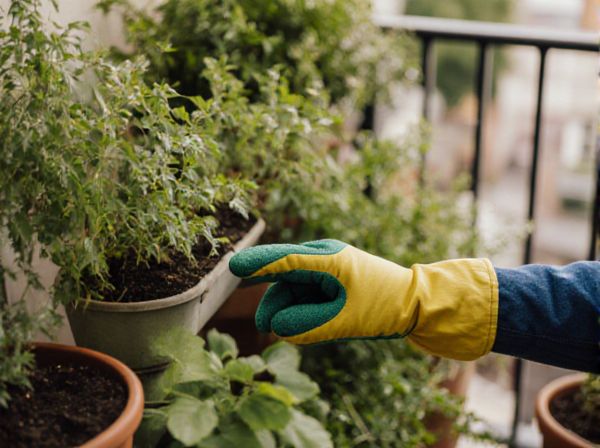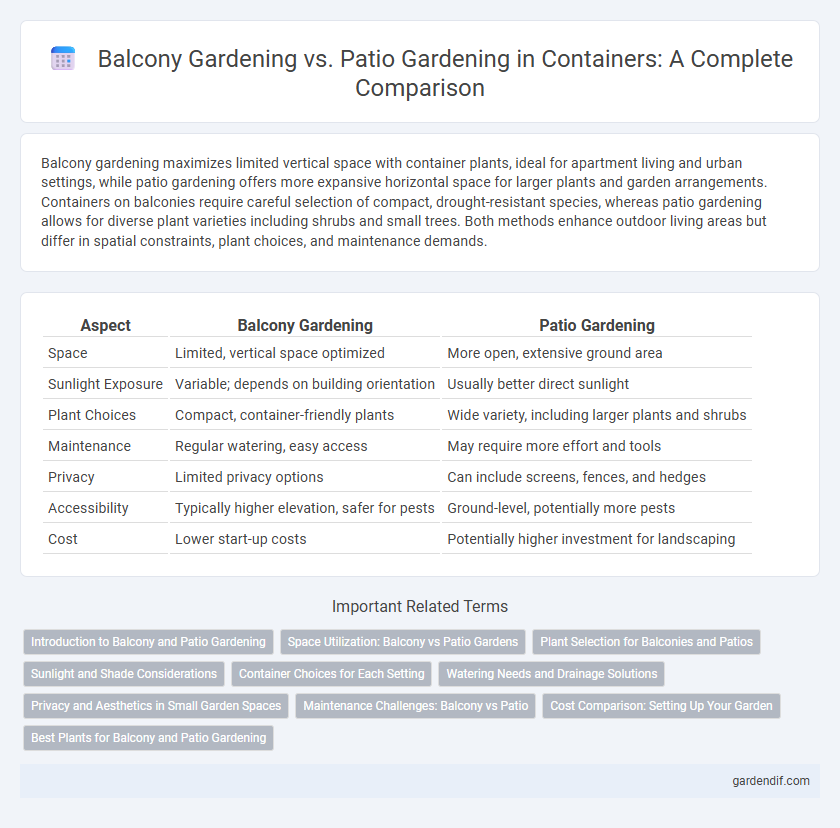
Balcony gardening vs patio gardening Illustration
Balcony gardening maximizes limited vertical space with container plants, ideal for apartment living and urban settings, while patio gardening offers more expansive horizontal space for larger plants and garden arrangements. Containers on balconies require careful selection of compact, drought-resistant species, whereas patio gardening allows for diverse plant varieties including shrubs and small trees. Both methods enhance outdoor living areas but differ in spatial constraints, plant choices, and maintenance demands.
Table of Comparison
| Aspect | Balcony Gardening | Patio Gardening |
|---|---|---|
| Space | Limited, vertical space optimized | More open, extensive ground area |
| Sunlight Exposure | Variable; depends on building orientation | Usually better direct sunlight |
| Plant Choices | Compact, container-friendly plants | Wide variety, including larger plants and shrubs |
| Maintenance | Regular watering, easy access | May require more effort and tools |
| Privacy | Limited privacy options | Can include screens, fences, and hedges |
| Accessibility | Typically higher elevation, safer for pests | Ground-level, potentially more pests |
| Cost | Lower start-up costs | Potentially higher investment for landscaping |
Introduction to Balcony and Patio Gardening
Balcony gardening transforms limited vertical spaces into lush green retreats using containers, maximizing sunlight exposure and air circulation for growing herbs, flowers, and small vegetables. Patio gardening offers a versatile outdoor area for larger container arrangements, allowing a broader range of plants and decorative elements in customizable layouts. Both methods enhance urban living spaces by optimizing container selection, soil quality, and watering techniques suited to their unique environments.
Space Utilization: Balcony vs Patio Gardens
Balcony gardening maximizes vertical and compact space, ideal for small urban areas with limited square footage, using rail planters, hanging pots, and tiered shelves. Patio gardening offers more horizontal space for larger containers, raised beds, and a variety of plant arrangements, accommodating heavier soil volumes and bigger plants. Efficient space utilization depends on garden size, plant types, and container selection tailored to either balconies or patios for optimal growth and aesthetics.
Plant Selection for Balconies and Patios
Balcony gardening favors selecting compact, lightweight plants such as herbs, succulents, and dwarf vegetables that thrive in limited space and partial sunlight conditions. Patio gardening allows for a broader range of plant varieties, including larger flowering shrubs, fruiting plants, and ornamental trees, benefiting from more extensive soil volume and full sun exposure. Optimizing plant selection based on area, sunlight, and container size ensures healthy growth and maximizes aesthetic appeal for both balconies and patios.
Sunlight and Shade Considerations
Balcony gardening typically requires plants that thrive in partial sun or shade due to limited direct sunlight and proximity to buildings, while patio gardening often offers more exposure to full sunlight for longer periods. Selecting sun-tolerant plants like succulents or herbs suits balconies with bright but indirect light, whereas patios can accommodate sun-loving species such as tomatoes and peppers. Understanding the microclimate related to sunlight and shade on each container garden ensures optimal plant growth and health.
Container Choices for Each Setting
Balcony gardening requires compact, lightweight containers such as hanging pots, rail planters, and self-watering containers to maximize limited space and support vertical growth. Patio gardening allows for larger, heavier containers like ceramic pots, raised beds, and wooden planters that accommodate bigger plants and improved drainage. Selecting containers with appropriate materials and sizes ensures optimal plant health and aesthetic appeal in each specific outdoor setting.
Watering Needs and Drainage Solutions
Balcony gardening requires careful management of watering needs due to limited soil volume and faster drying of containers, often benefiting from self-watering pots or drip irrigation systems to maintain soil moisture. Patio gardening typically allows for larger containers with better drainage solutions such as raised beds or perforated pots, facilitating efficient water runoff and preventing root rot. Proper drainage is crucial in both settings to avoid waterlogging, but balcony gardeners must prioritize lightweight, well-draining soil mixes to support container plant health.
Privacy and Aesthetics in Small Garden Spaces
Balcony gardening enhances privacy by utilizing vertical planters and trellises that shield views while optimizing limited space, creating a lush, secluded retreat. Patio gardening allows for more extensive arrangements with potted plants and garden screens, offering flexible design options that blend aesthetics with functional privacy barriers. Both approaches increase greenery and visual appeal in small garden spaces, but balcony gardens maximize privacy through compact, upward-growing vegetation, whereas patios provide broader layout possibilities for privacy customization.
Maintenance Challenges: Balcony vs Patio
Balcony gardening presents unique maintenance challenges due to limited space, requiring careful plant selection and frequent watering to prevent soil drying in confined containers. Patio gardening benefits from larger areas that accommodate diverse plant species and reduce water evaporation but demands consistent weed control and soil management. Both settings necessitate regular monitoring for pests and diseases, with balcony gardens often requiring more precise microclimate adjustments.
Cost Comparison: Setting Up Your Garden
Balcony gardening typically requires less investment, utilizing compact containers and vertical planters suited for limited space, resulting in lower initial costs. Patio gardening often demands larger beds, more robust soil amendments, and potentially irrigation systems, increasing setup expenses. Both options can be budget-friendly with DIY solutions, but balcony gardens generally offer a more economical entry point for urban gardening enthusiasts.
Best Plants for Balcony and Patio Gardening
Succulent plants such as jade and echeveria thrive in balcony gardening due to their low water needs and compact size, perfect for limited space. Patio gardening benefits from larger plants like tomatoes, peppers, and basil, which require more sunlight and space for growth. Both environments support herbs like mint and rosemary, offering fresh flavors with minimal maintenance.
Balcony gardening vs patio gardening Infographic

 gardendif.com
gardendif.com